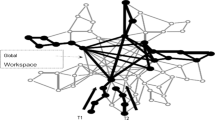Abstract
This paper reviews computational work that is currently developing under the heading of ‘Machine Consciousness’ and sets out to provide a guide for those who wish to contribute to this field. First, questions of philosophical concern as to the appropriateness of this activity are raised and discussed. Then some classical designs and computational attitudes are described before arguing that fine-grain neural approaches are needed to provide truly phenomenal representations that stand in relation to the behaviour of a computational organism as subjective mental states stand in relation to the existence of a conscious organism. The paper concludes with an evaluation of the validity and benefits of designing conscious systems.

Similar content being viewed by others
Notes
This suggests that science can only be done on the physical (body) and only correlations can be found to the subjective (mind). Chalmers has argued that the ‘hard problem’ for science is that it cannot prove that the physical implies the subjective.
The term ‘mind’ needs definition within the virtual consciousness paradigm developed here. If a mental state is the current content of the consciousness of an organism, mind, as the capacity of all possible mental states as organised into a state structure, is the state structure of the organism.
Lee has a PhD thesis (London University) in preparation on this topic: Aspects of affective action choice: computational modelling.
The author is grateful to Ricardo Sanz of Madrid Universtiy for this example.
References
Chalmers D. The conscious mind: in search of a fundamental theory. Oxford: Oxford University Press; 1996.
Penrose R. The emperor’s new mind. Oxford: Oxford University Press; 1989.
Baars B. A cognitive theory of consciousness. New York: Cambridge University Press; 1988.
Shanahan M. Cognition, action selection and inner rehearsal. In Proceedings IJCAI workshop on modelling natural action selection; 2005. p. 92–99.
Dehaene S, Naccache L. Towards a cognitive neuroscience of consciousness: basic evidence and a workspace framework. Cognition. 2001;79:1–37.
Haikonen P. The cognitive approach to conscious machines. Exeter, UK: Imprint Academic; 2003.
Haikonen P. Robot Brains: circuits and systems for conscious machines. Chichester: Wiley; 2007.
Block N. ‘What is functionalism?’. The encyclopedia of philosophy supplement. New York: Macmillan; 1996
Sloman A, Chrisley R. Virtual machines and consciousness. J Consciousness Stud. 2003;10(4–5):133–72.
Dennett D. Consciousness explained. Boston: Little, Brown; 1991.
Holland O, Knight R, Newcombe R. A robot-based approach to machine consciousness. In: Chella A, Manzotti R, editors. Artificial consciousness. Exeter, UK: Imprint Academic; 2007. p. 156–73.
Hesslow G. Conscious thought as simulation of behaviour and perception. Trends Cognit Sci. 2002;6(2002):242–7.
Chella A, Frixione M, Gaglio S. Planning by imagination in CiceRobot, a robot for museum tours. In Proceedings of the AISB 2005 symposium on next generation approaches to machine consciousness: imagination, development, intersubjectivity, and embodiment; 2005. p. 40–49.
Husserl E. Logical investigations. London: Routledge; 1973 (English translation by JN Findlay, Original in German; 1901).
Aleksander I, Morton HB. An introduction to neural computing. London: Chapman and Hall; 1990.
Aleksander I. The world in my mind, my mind in the world: key mechanisms of consciousness in humans, animals and machines. Exeter, UK: Imprint Academic; 2005.
Tononi G. An information integration theory of consciousness. BMC Neurosci. 2004;5:42.
Seth A. Explanatory correlates of consciousness: theoretical and computational challenges. Cogn Comput. (this issue). doi:10.1007/s12559-009-9007-x.
Gamez D. The development and analysis of conscious machines. University of Essex, PhD thesis in computing; 2008.
Franklin S, Baars BJ, Ramamurthy U. A phenomenally conscious robot? APA Newslett 2008;2(2):2–4.
Author information
Authors and Affiliations
Corresponding author
Rights and permissions
About this article
Cite this article
Aleksander, I. Designing Conscious Systems. Cogn Comput 1, 22–28 (2009). https://doi.org/10.1007/s12559-009-9008-9
Published:
Issue Date:
DOI: https://doi.org/10.1007/s12559-009-9008-9




